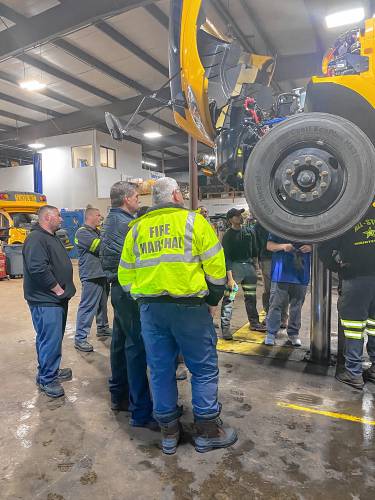Electric school buses are about to hit the road in Henniker and Weare
| Published: 04-28-2024 11:08 AM |
The era of electric school buses has finally arrived in New Hampshire bringing less pollution, less road noise and maybe even students who are less rambunctious.
“Anecdotally it brings the noise of the students down on the bus, because they’re not shouting over the engine,” said Rachel Lane, vice president of Electrification & Sustainability at Student Transportation of America, which operates bus services for a number of school systems. “I have heard bits and pieces where the kids on these buses, they come into school a little bit calmer because their ride has been calmer. Are there any scientific studies on that? No, but it’s the things you hear.”
Four electric buses of the IC bus brand, owned by Navisar, have arrived at the SAU24 bus terminal on Carding Mill Road in Weare, and are slated to serve the Henniker School District.
They look exactly like transitional buses of the style known as Type C, with the engine in front of the driver and around 80 seats, and they largely operate the same, although the lack of a tailpipe means they don’t produce fumes when idling at a bus stop or a school. They are heavier than traditional buses, which can at times create limitations on routes.
Henniker is one of three districts in the state getting electric buses under the federal EPA Clean School Bus Program and apparently will be the first to put them on the road. Drivers and mechanics are being trained and the buses will go into operation before the end of the school year.
STA also holds training for local fire departments and first responders because accidents involving battery vehicles must be handled differently than those involving diesel or gasoline vehicles.
Bringing the buses to the depot in Weare was relatively easy, Lane said, partly because just four buses are involved but mostly because this is a former industrial site with a large electrical connection.
Charging many buses at once can require more electricity than is available at many buildings, requiring either the installation of more transformers, which drop the voltage from existing distribution lines to make it available for use, or even installation of new feeder lines to bring more electricity to the location. This can add tens of thousands of dollars to set-up costs as well as long delays.
Article continues after...
Yesterday's Most Read Articles
 Neighboring landowner objection stalls Steeplegate redevelopment approval
Neighboring landowner objection stalls Steeplegate redevelopment approval
 How has Hopkinton, one of the smallest public schools in New Hampshire, become such a lacrosse powerhouse?
How has Hopkinton, one of the smallest public schools in New Hampshire, become such a lacrosse powerhouse?
 For some older Jewish professors at Dartmouth and UNH, opposition to campus arrests feels personal
For some older Jewish professors at Dartmouth and UNH, opposition to campus arrests feels personal
 Northeast Coffee Festival comes to Concord this weekend
Northeast Coffee Festival comes to Concord this weekend
 Driven by capital projects, city budget proposal would boost spending by $40 million
Driven by capital projects, city budget proposal would boost spending by $40 million
 Henniker Handmade & Homegrown
Henniker Handmade & Homegrown
“Every site is different,” said Lane. “We had enough power on the site. That is huge.”
One thing that won’t be happening any time soon is vehicle-to-grid, or V2G, in which some of the electricity stored in a bus battery is sold back into the grid when needed, such as during peak usage when electricity prices are high. School buses are perfect for V2G because they have large batteries and spend much of their time sitting in the garage, leading to the possibility that they could become a source of income for school districts by storing and selling electricity, especially when school isn’t in session.
However, Lane said, the technology is still in its infancy.
“It’s very complicated. We’re trying to find a place to do it,” she said. “You need the right buses, chargers and a supportive utility to bring everything together. … There are upfront costs for special kinds of chargers, it’s not a seamless installation. Making it work is challenging.”
Electric school buses cost at least twice as much as diesel buses. The Henniker buses were made possible by grants from the EPA, which awarded $4.2 million to enable the four buses, plus three at Rumney and three at Plymouth.




 Adam Montgomery sentenced to minimum 56 years on murder charges in young daughter’s death
Adam Montgomery sentenced to minimum 56 years on murder charges in young daughter’s death Following budget cut, Pembroke revisits future of elementary school re-build
Following budget cut, Pembroke revisits future of elementary school re-build Granite Geek: Free government software for taxes – what could go wrong? (Not much, as it turns out)
Granite Geek: Free government software for taxes – what could go wrong? (Not much, as it turns out)
